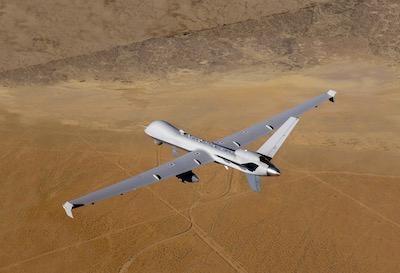Wed, Jan 15, 2020
Brake System Design Also Contributed To The Accident
The U.S. Air Force has released a report stating the cause of an accident involving an MQ-9A Reaper unmanned aircraft which departed a runway at an undisclosed location on September 3, 2018.

According to the report, the Mishap Aircraft (MA) was assigned to the 27th Special Operations Wing (SOW) at Cannon Air Force Base (AFB), New Mexico, and was flown by a Launch and Recovery Element (LRE) crew deployed to the undisclosed location from the 489th Attack Squadron (ATKS), 432nd Operations Group, 432nd Wing, Creech Air Force Base, Nevada.
The Mishap Crew (MC) received an “Engine – metal detected” red warning 10 minutes after takeoff, turned back towards the field and established an orbit to begin fuel dumping. Nine minutes later the engine oil pressure exceeded the limit of 126 pounds per square inch (psi) and the MC received a red warning. Per Aeronautical Systems Incorporated ASI-11114, Flight Manual, the MC elected to make an immediate straight-in landing using engine out procedures due to the possibility of catastrophic engine failure. Upon touchdown the propeller failed to go into reverse and the MA departed the prepared surface; according to Aeronautical Systems Incorporated ASI-11114, Flight Manual, the MQ-9A relies primarily on reverse thrust to slow and stop the aircraft upon landing.
After departing the runway, the MA caught fire and was destroyed with all modifications and four missiles. The resulting loss was valued at $12,726,187. There were no fatalities or damage to private property.
The Abbreviated Accident Investigation Board President found, by the preponderance of the evidence, the cause of the mishap to be the design of the engine. Further, the Board President found, by the preponderance of the evidence, the delay between engine Spectrometer Oil Analysis Program (SOAP) samples being taken and analyzed, as well as the design of the MQ-9A brake system, to be substantially contributing factors.
(Image from file)
More News
From 2021: The Inside Skinny On What Being An ANN Oshkosh Stringer Is All About By ANN Senior Stringer Extraordinare, Gene Yarbrough The annual gathering at Oshkosh is a right of p>[...]
Video Showed That During The Takeoff, The Nose Baggage Door Was Open On May 10, 2025, about 0935 eastern daylight time, a Piper PA-32RT-300, N30689, was destroyed when it was invol>[...]
Get The Latest in Aviation News NOW on Instagram Are you on Instagram yet? It's been around for a few years, quietly picking up traction mostly thanks to everybody's new obsession >[...]
"I think what is key, we have offered a bonus to air traffic controllers who are eligible to retire. We are going to pay them a 20% bonus on their salary to stay longer. Don't reti>[...]
Aero Linx: Pilot Briefing The gathering, translation, interpretation, and summarization of weather and aeronautical information into a form usable by the pilot or flight supervisor>[...]
 Oshkosh Memories: An Aero-News Stringer Perspective
Oshkosh Memories: An Aero-News Stringer Perspective NTSB Prelim: Piper PA32RT
NTSB Prelim: Piper PA32RT ANN FAQ: Follow Us On Instagram!
ANN FAQ: Follow Us On Instagram! Aero-News: Quote of the Day (05.28.25)
Aero-News: Quote of the Day (05.28.25) ANN's Daily Aero-Term (05.28.25): Pilot Briefing
ANN's Daily Aero-Term (05.28.25): Pilot Briefing



